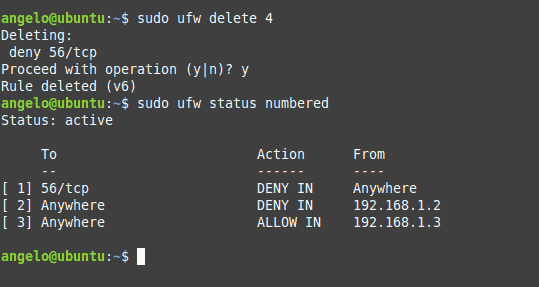$ sudo ufw allow 2020/tcp The following rules allow access to tcp ssh port 22 only on 10.8.0.1 (i.e. Your ssh server is listing on 10.8.0.1 port 22) from anywhere: $ sudo ufw allow proto tcp from any to 10.8.0.1 port 22. $ sudo ufw default deny incoming $ sudo ufw default allow outgoing $ sudo ufw allow ssh Step 5: IPv6 Configuration for Firewall on Ubuntu Linux. It would help if you opened the firewall configuration script using any script editor to configure the IPv6 (Internet Protocol, version 6) on Ubuntu Linux. In my case, I am using the Nano editor to. Sudo ufw allow from 15.15.15.15 to any port 22 sudo ufw allow from 15.15.15.15 to any port 21 Port 22 is the defaut for SSH, 21 is the default for FTP. You can replace 15.15.15.15. The quickest way to manually add a new rule for a different SSH port would be with the following command: sudo ufw allow /tcp inserting your particular port into the command. While you haven't specifically asked, remember that you need to make your port number change in the file /etc/ssh/sshdconfig.
Я использую сервер ubuntu. Теперь я пытаюсь включить брандмауэр, используя следующие команды:


Я также попытался сделать ufw default deny incoming последним, но все равно не повезло, когда я ufw default deny incoming брандмауэр, он блокирует eveything, когда я устанавливаю значение по умолчанию для отказа, но когда я его разрешаю, он работает хорошо, как правила игнорируются. Что может быть причиной этого ?
РЕДАКТИРОВАТЬ
Это мой вывод iptables -L -v -n Я также пробовал предлагаемое решение, но все равно не повезло, он отлично работает, только когда я делаю его по default allow incoming
Откройте терминал и введите следующие команды:
Начните с выполнения сброса, который удалит все существующие правила:
Следующий,
В нем будут перечислены доступные профили приложений, такие как OpenSSH и другие. Чтобы получить информацию о приложении, введите следующую команду, как в этом примере:
Вот результат:
Чтобы разрешить доступ к OpenSSH, вы можете использовать следующее правило:
В отличие от Debian, www и https обычно не входят в состав профилей приложений, однако мы знаем, что они работают на портах 80 и 443, поэтому используйте следующие команды:
Если вы хотите добавить UDP, просто сделайте это.

Отключите и включите ufw, чтобы применить изменения:
Чтобы показать свои правила:
Наконец, один из менее дружественных аспектов ufw – это то, как правила запрета обычно козыряют правила. Например, вы не можете установить все, чтобы запретить, а затем установить разрешенные порты. Все порты будут по-прежнему заблокированы. См. Здесь для получения дополнительной информации .
Вы можете добавить эти правила, чтобы глобально блокировать все порты, кроме 22, 53, 80 и 443. Я добавил порт 53, чтобы разрешить DNS-запросы. Если вам не нужно делать DNS-запросы, просто измените соответствующие правила.
Чтобы установить эти правила блокировки только для входящих, вы должны использовать sudo ufw deny in 1:22/tcp . В качестве альтернативы, установите для исходящего sudo ufw deny out 1:22/tcp и так далее.
Ubuntu comes pre-installed with a firewall configuration tool, UFW (Uncomplicated Firewall). UFW is easy to use for managing server firewall settings.

This tutorial shows you how to disable and enable an Ubuntu UFW firewall using the command line.
- Command line / terminal window
- User with root or sudo privileges
Before disabling the UFW firewall, it is a good idea to check its status first. In Ubuntu, the firewall is disabled by default. How do you know if your firewall is on?
To check the current status of the firewall, execute the command in your command terminal:
In this example below, the output shows that the firewall is active.
As we have determined the current state, now we can proceed to disable the UFW firewall.
A firewall is a vital element in a network and server security. However, while testing or troubleshooting, you might need to shut down or stop the firewall.
To disable the firewall on Ubuntu, enter:
The terminal informs you that the service is no longer active.
If you disable the firewall, keep in mind that your firewall rules are still in place. Once you enable the firewall again, the same rules that were set up prior to the deactivation will apply.
Learning how to enable the firewall on Ubuntu is vital.
To enable the firewall on Ubuntu, use the command:
As with the ‘disable’ command, the output confirms that the firewall is once again active.
UFW does not provide complete firewall functionality via its command-line interface. However, it does offer an easy way to add or remove simple rules.
A good example is opening an SSH port.
For example:
Once the terminal confirms that the rule is now in place, check the status of the firewall with the ‘status’ command:
The output is going to reflect the fact that an SSH port is now open.
Ufw Allow In On Interface
If you need to reset all rules back to default settings, use the reset command:
After confirming the action, by typing y, the firewall settings revert to their default values.
In this guide, you learned how to disable and stop the firewall on Ubuntu. We also showed you how to enable the firewall and reset settings.
Now you know the options available with the UFW tool. These commands provide an excellent foundation to explore firewall functions and settings.
Next you should also read
UFW is a simple interface implemented on top of iptables that provides an easier way to configure a firewall.…
This phoenixNAP guide instructs how to enable and start firewalld on CentOS 7. It explains basic firewall…
Ufw Block Ssh
Apache Tomcat is a free, open-source, lightweight application server used for Java-based web applications.…
Ufw Allow Ip
FTP stands for File Transfer Protocol. It is similar to HTTP (HyperText Transfer Protocol), in that it…

